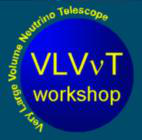M.
Ronald Stubberfield
(ET Enterprises)
23/04/2008 09:00
Parallel Session on Photodetection
Contributed talk
ET Enterprises Limited is a new UK company which has taken over manufacture and supply of the Electron Tubes brand photomultipliers and associated hardware to meet the needs of detector users in industry and research around the world. Although a new company, its history goes back to the 1930s when, as part of EMI, it first became involved with light detection technologies and the development...
M.
Yuji Yoshizawa
(Hamamatsu Photonics)
23/04/2008 09:30
Parallel Session on Photodetection
Contributed talk
Recent activities for large format PMTs in Hamamatsu are shown. First topic is the development of 12 inch PMT. Hamamatsu decided to develop 12 inch PMT for the use of neutrino experiments. As you know, several large-scale neutrino experiments are being considered right now. We would like to offer 12 inch PMT as one of options. Second topic is High QE photocathode. Hamamatsu succeeded to make...
Dr
Christian Joram
(CERN / PH Department)
23/04/2008 10:00
Parallel Session on Photodetection
Contributed talk
The concept of hybrid photodetectors which combine a large area photocathode with a crystal scintillator anode in the centre of a hemispherical vacuum tube was demonstrated first with the Philips SMART tubes and, more recently, with the QUASAR tubes of the Lake Baikal experiment. Photoelectrons from the cathode are accelerated by a potential difference of 20-30 kV and deposit their kinetic...
G Hallewell
(Centre de Physique des Particules de Marseille)
23/04/2008 11:00
Parallel Session on Photodetection
Contributed talk
Scintillating crystal-based hybrid photon detectors have been demonstrated as viable single photon detectors since 1996 in the Lake Baikal neutrino telescope. Prior to this, the Philips XP2600 'SMART' X-HPD had been developed under the DUMAND program, while more recently, developments at CERN have demonstrated the advantages of a true concentric geometry with a scintillator at the geometric...
Dr
Bayarto Lubsandorzhiev
(Institute for Nuclear Research of RAS)
23/04/2008 11:30
Parallel Session on Photodetection
Contributed talk
The advent of the first generation of neutrino telescopes gave impetus to the development of hybrid phototubes with luminescent screens. The phototubes have been used in the two pioneering neutrino telescope projects - Deep Underwater Muon and Neutrino Detector (DUMAND) in the Pacific Ocean and the Lake Baikal neutrino experiment. In this paper we summarize a wealth of experience accumulated ...
Prof.
Gisela Anton
(Erlangen Centre for Astroparticle Physics)
23/04/2008 12:00
Parallel Session on Photodetection
Contributed talk
A new concept of a hybrid photodetector is presented. It consists of a standard photocathode combined with the TIMEPIX semiconductor detector. The photoelectron is accelerated in a field of 10 to 20 keV to the silicon sensor of the TIMEPIX. The photoelectron generates electron-hole pairs in the silicon which are directed to the pixel electronics of the TIMEPIX ASIC. This charge signal is...
Prof.
Herbert Loehner
(KVI, University of Groningen)
23/04/2008 14:00
Parallel Session on Photodetection
Contributed talk
For the KM3NeT neutrino telescope an optical module with a number of small phototubes (multi-PMT optical module) will be advantageous for various reasons, e.g. reduced background rate, a larger number of coincidence hits and ultra-high neutrinos can be detected. The properties of such a design have been investigated by measurements and simulations. Several types of 3” PMT were exposed to LED...
Dr
Andrea Bersani
(INFN Genova)
23/04/2008 14:30
Parallel Session on Photodetection
Contributed talk
An efficiency increase in the intermediate energy region for an underwater neutrino telescope could be an important development to gain a better sensitivity in the study of the physical processes concerning the deep universe and to have a useful tool for better detector calibration with atmospheric neutrinos. A new, direction sensitive, segmented optical module is under development in Genova:...
Dr
Emanuele Leonora
(INFN CATANIA)
23/04/2008 14:45
Parallel Session on Photodetection
Contributed talk
A prototype of a new large area (10”) 4-anodic photomultiplier, manufactured by Hamamatsu for the NEMO collaboration, will be used for the first time for the construction of a Km3 scale neutrino underwater telescope, in the KM3NeT framework. Using testing facility realized in our laboratory, we have performed tests on prototype performances at room temperature, atmospheric pressure and...
Bayarto Lubsandorzhiev
((Institute for Nuclear Research of RAS))
23/04/2008 15:00
Powerful nanosecond light sources based on LEDs have been developed for use in calibration systems of deep underwater neutrino experiments. The designs of such sources are described. The light sources use either matrixes of ultra bright blue InGaN LEDs or a new generation of high power blue LEDs. The drivers of such LEDs may be implemented of avalanche transistors or a complementary pair of...
Mlle
Jessica Craig
(Oceanlab , University of Aberdeen)
23/04/2008 15:20
Parallel Session on Photodetection
Contributed talk
The density of bioluminescent organisms was measured in the eastern and western Mediterranean, from the subsurface layer to the seafloor; in the Ligurian, Tyrrhenian, Ionian, Adriatic Seas and the Straits of Sicily, including neutrino telescopes sites at ANTARES and NESTOR. Bioluminescence decreased with depth at different rates at the different sites. At depths 500-1500m, the Adriatic was...

